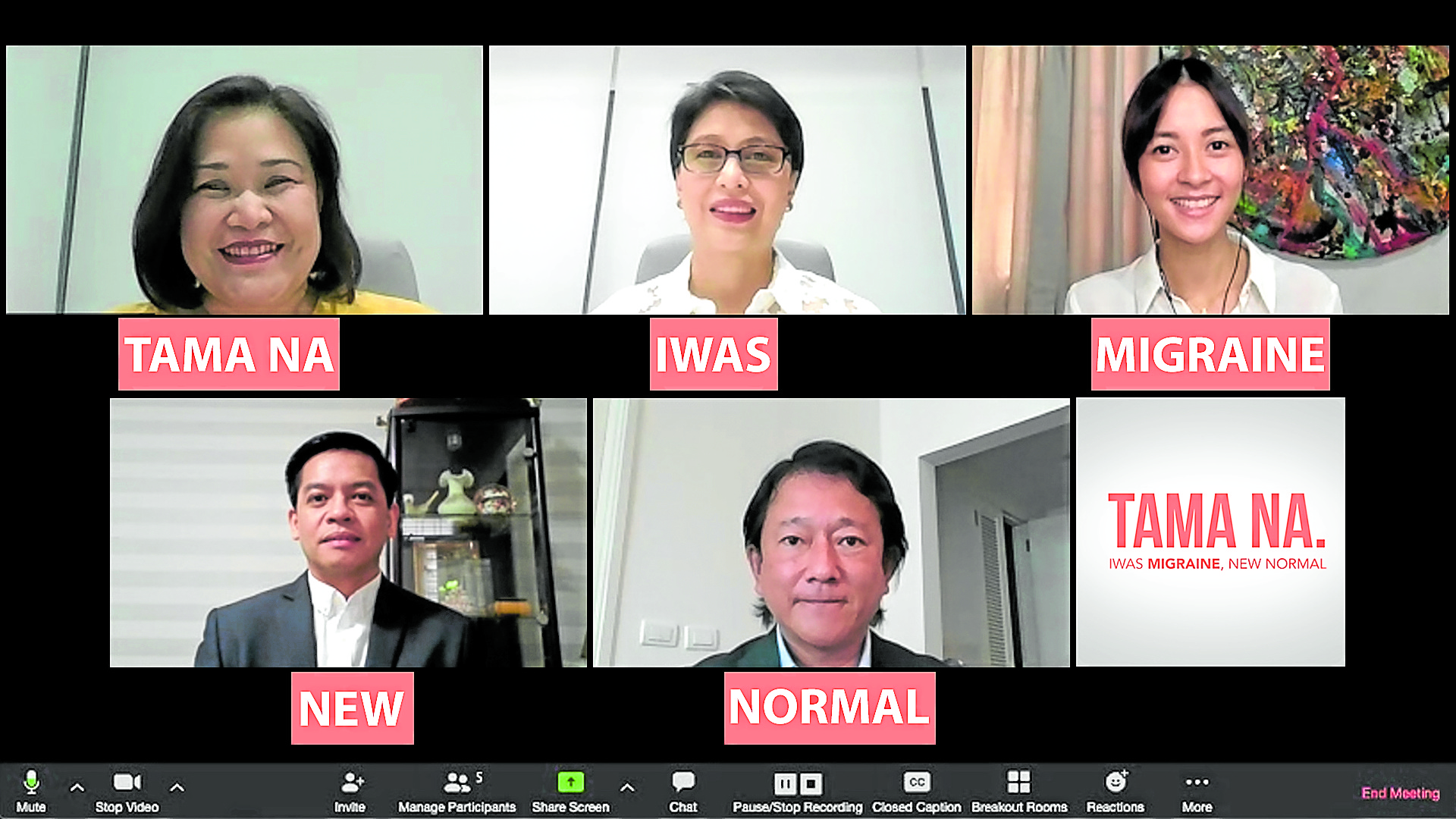
The extended quarantine in Metro Manila and Luzon could have easily triggered migraines among Filipinos. The numbers aren’t in yet, since doctors’ clinics are closed except for emergencies.
“But it makes sense that in this very abnormal situation, you will have more migraine cases. The biggest culprit is sleep,” Dr. Rosalina Espiritu-Picar, president of Philippine Neurological Association (PNA), told Lifestyle. “The biggest problem with having an unstructured life because of the pandemic is that you don’t have regular working hours, so sleep is also very irregular.”
Stress and anxiety caused by the pandemic have an impact on people suffering from migraine.
During the virtual media briefing “Tama Na, Iwas Migraine, New Normal” organized by Novartis Healthcare Phils., Picar explained that pain has a biopsychosocial model.
3 components
There are three components involved, Picar said: sleep, anxiety and depression, and pain.
“That means they feed off each other. That means people who don’t sleep well tend to have more pain, and people who tend to have pain also tend to have more anxiety and depression. And that relationship is bidirectional,” Picar said.
Any increase in anxiety, any difficulty in sleep, and any uncontrolled pain can cause changes in sleep and anxiety, and vice versa, she said.
“What we need to understand and what an enlightened patient can do is to understand that there are different kinds of headaches. You need to stop that headache fast. If you don’t stop it right away, it could snowball,” Picar said.
Dr. Corina Maria Socorro Azores-Macalintal, a neurologist at Asian Hospital and Medical Center, said the lockdown may trigger more headaches, especially for those prone to anxiety. Anxiety is a trigger, and stress is a major trigger for migraines, she said.
“But If you’re treated well, you’re not supposed to suffer long,” Macalintal said. “Headache may be a manifestation of COVID-19 (new coronavirus disease), but it is not as common as other symptoms like fever and dry cough. Migraine attacks may be more common these days because of stress and anxiety caused by the pandemic.”
Migraine management is individualized, so for treatment to succeed, it is essential to consult a neurologist. Macalintal said patients should exercise caution against medication overuse. There are pharmacological and nonpharmacological treatment options for migraine management.
Migraine patients and their neurologists should discuss treatment goals, and those include preventing recurrence.
Telemedicine
PNA has drafted telemedicine guidelines. To find a neurologist anywhere in the country and for a list of neurologists accepting telemedicine consultations, patients are encouraged to visit the official PNA website at www.philippineneurologicalassociation.com or call the trunkline of the hospital nearest them.
Telemedicine tools are a practical alternative to enable doctor-patient interaction while maintaining social distancing and complying with community quarantine protocols.“It’s very important to get the right diagnosis. And for the patient to understand that this is what I’m having now, and this is what I need to do. And that is why it’s very important that your doctor helps you and guides you in terms of managing your headaches, and you can function properly,” Macalintal said.
Not easy
Suffering from migraine and managing it are not easy.
TV host and model Bianca Gonzalez-Intal has suffered migraines since she was a child, she said. Her dad had them, too.
“It’s very difficult to be a migraine sufferer. My worst migraine attacks last three days… I used to be given hypertension medications to ease the pain,” she said.
Hosting can sometimes get a little tricky with all the bright lights and loud sounds, both migraine triggers. “I have to take a strong medicine and take a nap backstage before showtime, so I could ease my migraine headache, and be able to perform my role as host.”
Thankfully, she said, the strong support she received from her family who understands her pain, may have saved her from struggling with depression. Many who suffer from migraines also grapple with mental issues.
According to the Global Burden of Disease Study 2016, an estimated 12 million Filipinos suffer from migraines. The World Health Organization reports that close to 14 percent of people with COVID-19 experience headaches, which may include migraine headaches. A social media analysis done by Novartis found that the stress and anxiety induced by the COVID-19 pandemic have triggered migraine attacks in patients all over the world.
The primary stressor among migraine sufferers was the overlap of migraine and COVID-19 symptoms, like headache, nausea and vomiting. This has caused anxiety and fear among those with migraines, and the stress and anxiety only further triggered migraine attacks.
Migraine diary
Monitor migraine with available tools, such as the Migraine Buddy, an advanced migraine headache diary, and a tracking app designed with neurologists and data scientists. The Migraine Buddy app is available on the App Store and Google Play.
“Monitoring migraine attacks can help migraine sufferers recognize trigger factors and warning signs. It can also help the doctor assess if the patient’s migraine medication is working. The good news is that new treatment options on preventive migraine care are now available,” said Christine Fajardo, corporate affairs head of Novartis Healthcare Phils. INQTo learn more about migraine and join the conversation with fellow migraine sufferers,
visit www.facebook.com/speakyourmigraineph.